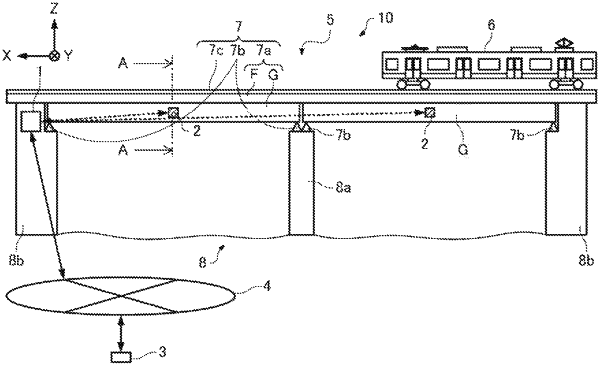| CPC B61L 25/021 (2013.01) [B61L 25/028 (2013.01); E01D 22/00 (2013.01); G01H 17/00 (2013.01)] | 14 Claims |

|
1. A measurement method for causing a processor to execute a process, the method comprising executing on the processor the steps of:
a first measurement data generation step of generating, based on observation data output from a sensor configured to observe an observation point of a superstructure of a bridge, first measurement data based on a physical quantity which is a response to actions of a plurality of parts of a vehicle moving on the superstructure on the observation point;
a second measurement data generation step of generating second measurement data in which a vibration component is reduced by performing filter processing on the first measurement data;
an observation information generation step of generating observation information including an entry time point and an exit time point of the vehicle with respect to the superstructure;
an average velocity calculation step of calculating an average velocity of the vehicle based on the observation information and environment information which is created in advance and includes a dimension of the vehicle and a dimension of the superstructure;
a first deflection amount calculation step of calculating, based on an approximate equation of deflection of the superstructure, the observation information, the environment information, and the average velocity, a first deflection amount of the superstructure caused by the vehicle;
a second deflection amount calculation step of calculating a second deflection amount in which a vibration component is reduced by performing filter processing on the first deflection amount;
a coefficient calculation step of approximating the second measurement data with a linear function of the second deflection amount to calculate a first-order coefficient and a zero-order coefficient of the linear function;
a third deflection amount calculation step of calculating a third deflection amount based on the first-order coefficient, the zero-order coefficient, and the second deflection amount;
an offset calculation step of calculating an offset based on the zero-order coefficient, the second deflection amount, and the third deflection amount;
a static response calculation step of calculating a static response by adding the offset and a product of the first-order coefficient and the first deflection amount;
a first dynamic response calculation step of calculating a first dynamic response by subtracting the static response from the first measurement data;
a second dynamic response calculation step of calculating a second dynamic response by performing filter processing for attenuating an unnecessary signal from the first dynamic response;
an envelope amplitude calculation step of calculating an envelope amplitude of the second dynamic response; and;
an attenuation rate calculation step of calculating, based on the envelope amplitude, an attenuation rate of a vibration component included in the second dynamic response; and
an abnormality detection step of detecting or monitoring an abnormality state of the superstructure of the bridge based on the attenuation rate of the vibration component.
|